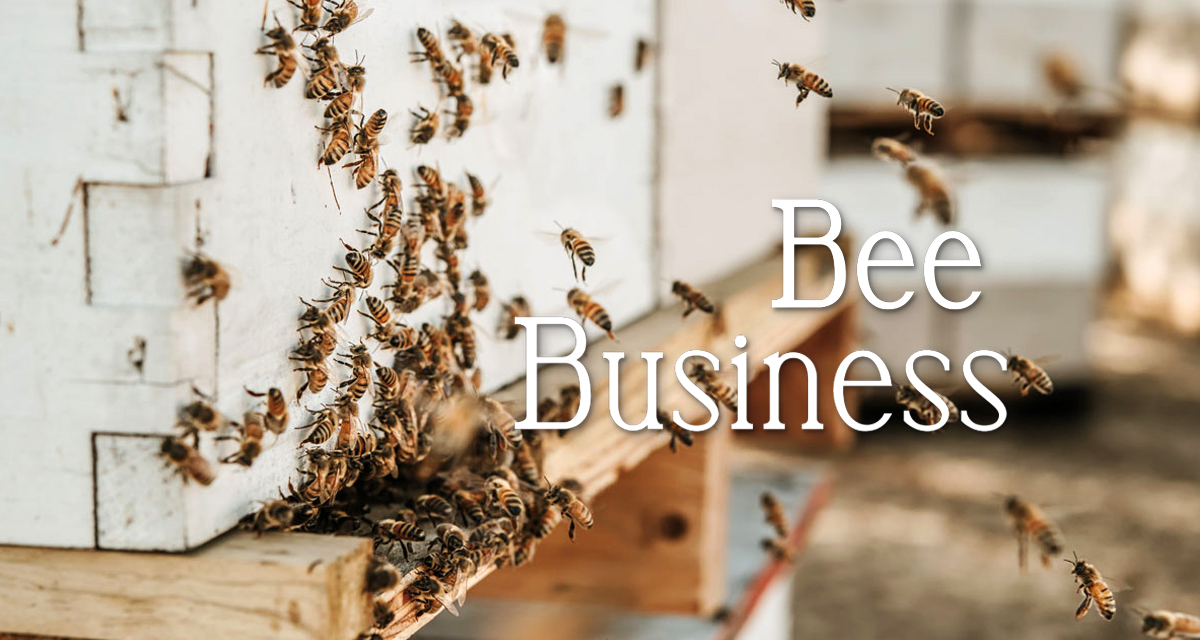By Dan England –
One of Lisa Boesen’s life missions is to help beekeepers and their hives not only survive but thrive. And one of the first things she recommends is not starting the way she did.
Boesen had a friend moving to Norway who had a couple hives. Boesen had wanted to keep bees but knew nothing about them. She thought (as many do) that her desire would be enough. She adopted one. It was difficult from the start.
The hive swarmed. In other words, nearly half of the hive left with a different queen, an elaborate and admittedly extreme way to ensure the survival of their species. But they took up residence in her neighbor’s yard, and Boesen had to pay to have it removed. Then her hive, handicapped by half, died in the winter. She grieved over it and cried many times.
“I get annoyed when ‘Good Housekeeping’ puts it out there that it’s beautiful to keep bees and it’s easy,” says Boesen, 62, of Fort Collins. “It’s a very serious hobby. It’s animal husbandry. It’s not any different than herding cattle. It’s not for the faint-hearted.”
Boesen is now in her fifth year of keeping bees, and she’s president of the Northern Colorado Beekeeper’s Association, a club that helps beekeepers, most of them hobbyists, keep a strong hive. She has strong hives now, and it’s still difficult.
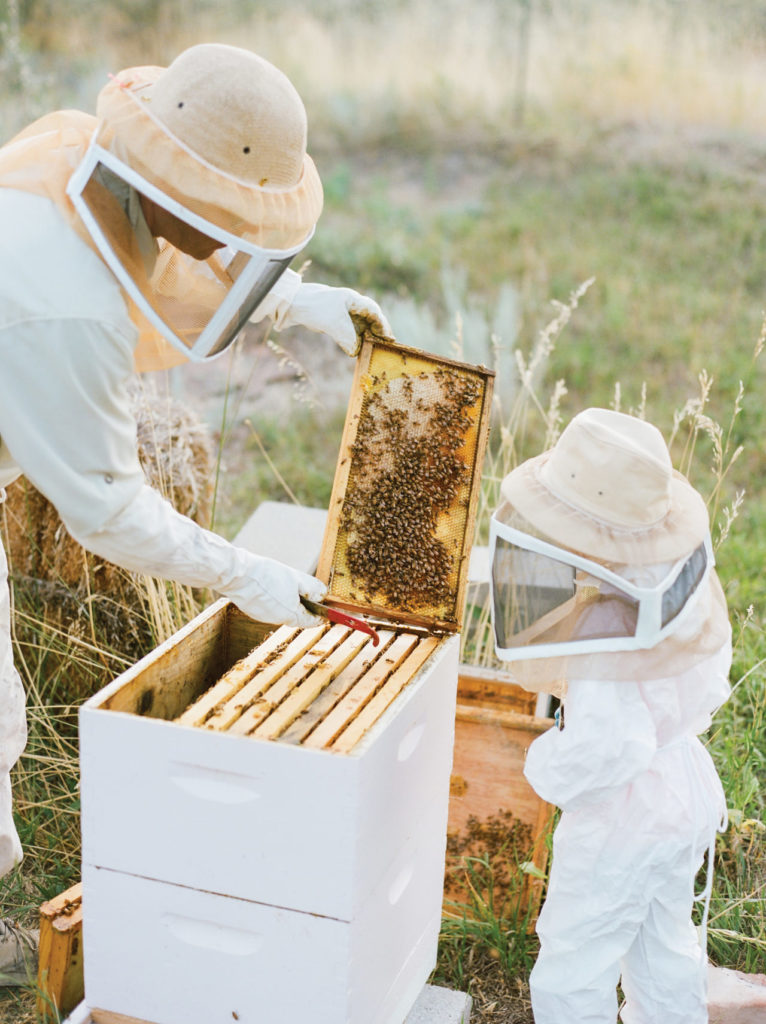
Local beekeeper Aaron with daughter, Anella, tending to their hive. Photo by Danielle DeFiore Photography.
Many beginners, not just Boesen, lose their hives after the first year. Even many veterans report losses of just under half their bees, even if a hive survives, and that’s every year. Bees are struggling, and there isn’t just one reason: Mites, pesticides, the suburbs’ obsession with green, clipped bluegrass lawns and just the fact that nature is cruel are all culprits, and they haven’t even studied how climate change is hurting them, Boesen says, though there are signs that abnormally hot temperatures make the bees (and everyone else) sluggish in the summer. Even well-meaning but rookie beekeepers can be a problem, as their bees can bring disease into other hives and wipe out nearby colonies.
Hobby beekeepers who may have just a couple hives need to prepare them for the winter, with a strong queen, and manage disease and pests, including that mite problem that’s wreaked havoc on bees (the pests compare to the size of a dinner plate on a human). Boesen has a mentor, and in the winter, the off-season for beekeepers, she studies an hour a day, largely by re-reading her copious notes.
Still, there are perks. It probably contributes to well-being, there are plenty of mentors available in the NCBA and Boesen’s honey was the Reserve Grand Champion at the Larimer County Fair this year. She doesn’t want to discourage you from trying if you’re ready, willing and able.
“It’s just magical,” Boesen says, “but it’s a lot of work to get it to that point.”
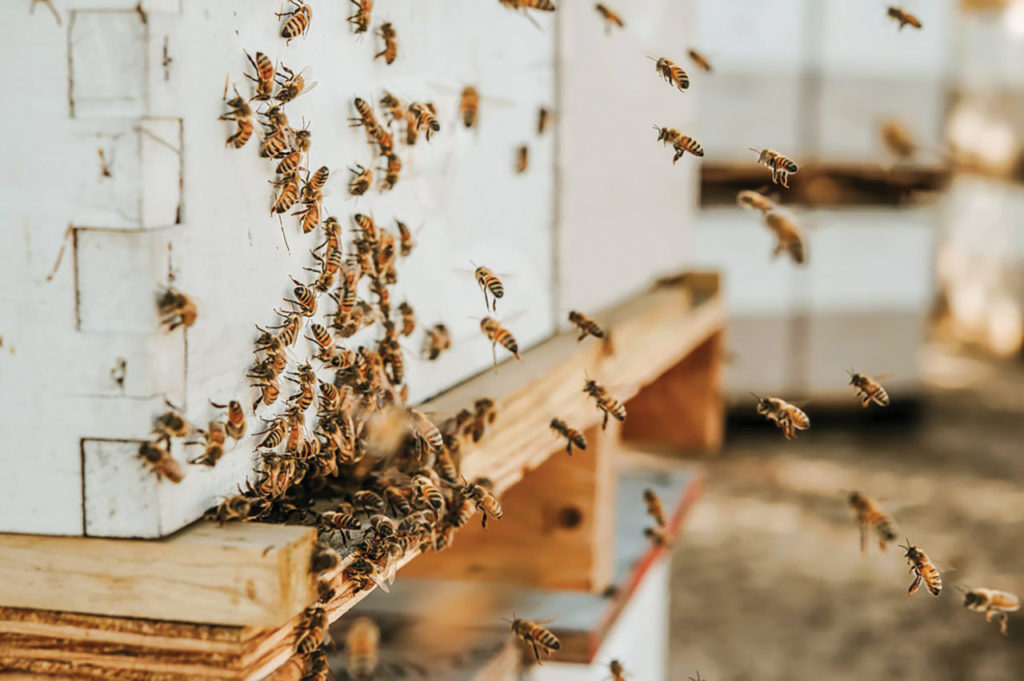
Bees swarm near their hive. Photo courtesy of Beeyond the Hive.
The beekeeping boom
Steve Andrijiw’s father was perhaps the only person he knew who kept bees as he was growing up.
This was before the early 2000s, when people began viewing bees as vibrant pollinators and not as little flying bugs that wanted to sting you.
“They were more in the news, and people were like, ‘Save The Bees,’” says Andrijiw, a professional beekeeping consultant with Front Range Sustainable Apiaries who serves all major cities in Northern Colorado. “Average people keeping bees was unheard of when I was a kid. It’s a big responsibility. It’s not like keeping fish in a tank. I can help them diagnose problems, but they must do the work.”
Many times, beginning beekeepers underestimate the work and expense it can take to get a hive going, Andrijiw says, and they don’t have the knowledge to monitor critical components of a hive, including the queen’s performance and the aforementioned mites, what he calls “the biggest challenge, hands down.”
“You really have to be paying attention to what’s going on,” he says, “and there’s a skill set that applies to all that. People have their own lives; they have to care for their family and go shopping and do all that stuff.”
Andrijiw says it’s best to wait until you have the right environment, neighbors who are OK with bees and the time to get into it.
“People can keep them in areas where Mother Nature doesn’t intend it,” he says.
That, unfortunately, can include Northern Colorado, with a high desert climate that doesn’t naturally produce tons of bee forage on its own. When we do plant, it’s usually a bluegrass lawn that doesn’t help the bees (see sidebar on how to build a backyard environment that helps bees and other critters).
In addition, nature isn’t nice. Humans bend the rules of natural selection so much that we tend to forget there are built-in controls for all species.
“Mother Nature doesn’t intend for all hives to survive,” Andrijiw says. “A hive can cast off two or three swarms in a season, and not all survive.”
Even businesses struggle
There are people who can do it and do it well. The Johnston family can whisper in bee language.
The Fort Collins family has kept hives since 1908, the oldest in Colorado, starting with Walter Leckenby, who sold honey from a wagon in front his house. Jeff Johnston established the Colorado Honey Company in 2001, a wholesale honey business that sells to bulk accounts nationwide, which includes breweries and bakeries. His sisters, Jamie and Jacy, created Beeyond The Hive, a retail business, in 2005. He also appreciates retail businesses Copoco’s Honey in Fort Collins, Bee Squared in Berthoud or Björn’s Colorado Honey in Boulder.
But commercial beekeepers aren’t doing well, either, even with all that expertise, and some of the problems don’t even have much to do with bees. “For every person I know getting into bees,” Johnston says, “I know 200 who are getting out. Not good.”
Prices for honey rose to record highs for the 2021 crop, but those profits were eaten by spiking shipping and fuel costs, and a rise in the cost of supplies such as trucks, hive hardware and new queens. And the days of symbiotic relationships between beekeeping and farms seem to be over: Most farms charge yard rent for land to keep those hives, and that is increasingly the only place they can go. Farmers also tend to chop their alfalfa crops down four times a summer, which leaves the bees searching even more for food.
“Ideally, you put the bees in locations where, if you look all around you in every direction, all you can see is the floral source (clover, canola, buckwheat, etc.),” Johnston says. “A location can only hold 36-48 hives due to limited resources for the bees. If you have 20,000 hives, where are you going to put all of them?”
The pros lose bees, too, up to 50 percent every year because of all the same factors that flummox hobbyists. This causes them to split their strong hives into two every spring and move them a few miles away, so the bees don’t figure it out.
“If ranchers lost half their herd of cows every year, that would be a problem,” he says, “but in the beekeeping world, it is just par for the course.”
Andrijiw, though, believes professional beekeepers have created some of their own problems by mass producing honey and keeping tens of thousands of hives in close proximity. He says these bee operations resemble cattle feedlots.
“That is an insane number of hives together,” he says. “Mother Nature would never do it that way. Pathogens are exchanged when they get all mashed in together, just like with cattle.”
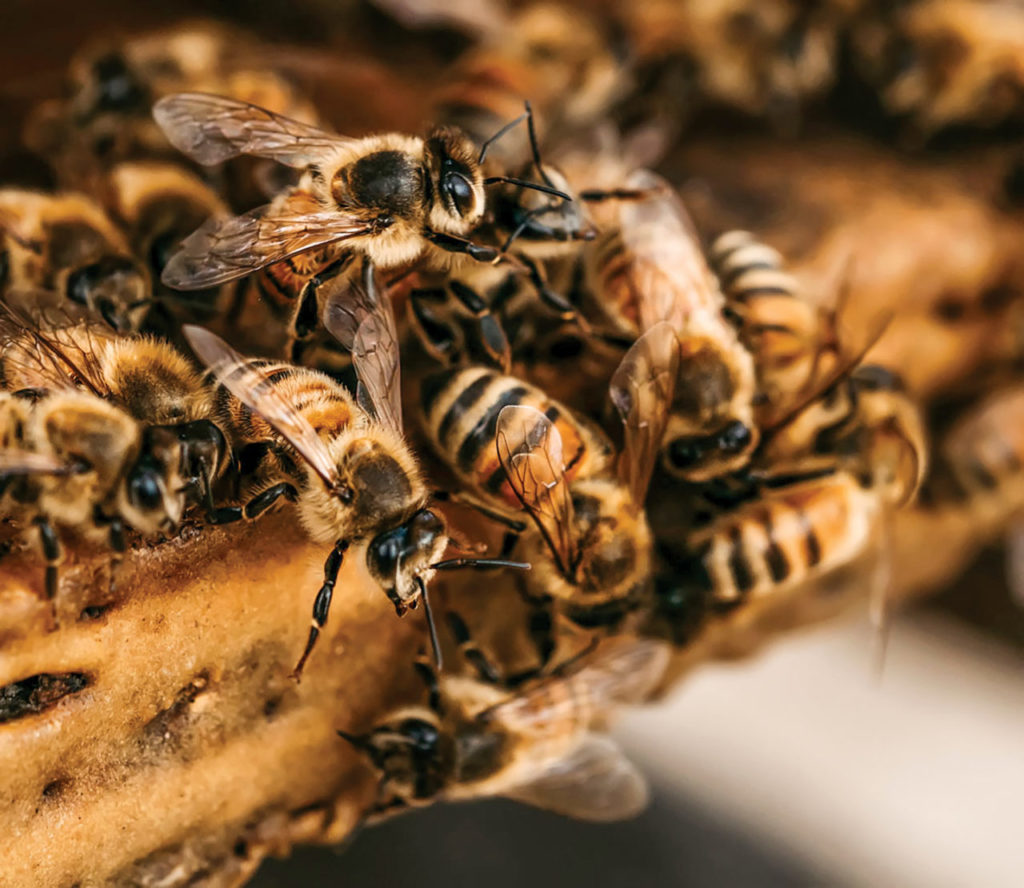
Photo courtesy of Beeyond the Hive.
A romantic buzz
All this doom could gouge all the romanticism out of beekeeping, but for now, there are always people such as Jenelle Kemper to keep it blooming. You can hear the excitement in her voice when she talks about her new hives. Granted, she is a 4-H volunteer for the Larimer County Extension Service and therefore regularly overdoses on optimism, but there’s an extra, um, buzz of excitement in her voice.
“I know NOTHING about it,” Kemper says, “but we’re gonna figure it all out together.”
“We,” in this case, are her two daughters, 10 and 7, and the 22 4-H kids—she expected three—who signed up to help her on her hobby farm in rural Larimer County. She has the property to do this, she says, so why not keep three hives? Plus, she knows more than nothing, as she took the beginner’s course from NCBA in December and received “more books than I can count” for Christmas.
Her daughters are not impressed, she says, but the 10-year-old will maintain a hive as one of her projects this year. Kemper knows she will likely be stung.
“But I figure it can’t be any worse than getting kicked by one of my horses,” she laughs. Her animals, she says, need alfalfa on a daily basis and she can’t imagine a world without bees to pollinate it.
“Look at how much these bees do for us,” Kemper says. “Look at what would happen if they were gone.”
Teresa Higgins, a professor of biological sciences at the University of Northern Colorado, used an observation hive to teach students about the ecosystem in 2019. She took the NCBA’s beginner’s course to learn how to keep the hive healthy, but even a biology professor’s breadth of knowledge wasn’t enough.
“It became apparent in the fall it wasn’t going to survive,” Higgins says. “The hive swarmed, and we don’t know if we had a queen afterward.”
The hive did indeed die, but Higgins hopes to try again this spring. The bees arrived in late April, this time with two hives, and she will use the observable hive to teach a course about beekeeping. Many of the students want to keep bees themselves, although the work already has intimidated a few of them.
“One said to me, ‘There’s a LOT to this, and I don’t know if this is for me right now,’” Higgins says.
The public can view the bees when the building is open, and Higgins acknowledges that the hive is “good PR” for UNC.
“I would like to see it succeed for our program,” Higgins says. “It’s a value for our community. It shows biology in action.”
Swarm Season
There’s a chance you could see a massive glob of bees in your yard this spring. But before you call an exterminator or grab a can of insecticide, consider calling a beekeeper.
The bees are likely in a swarm, where a portion of bees from a hive have left with a queen to form a new one. Beekeepers don’t love it when their hives swarm, but even then, there’s a grudging acceptance of nature.
“It’s nature’s way of saying we need to be fruitful and multiply,” says Lisa Boesen, president of the Northern Colorado Beekeepers Association.
There are more than 75 so-called “rescuers” in the association, and they will come out and take the bees and add them to their supply. They usually will not charge-the bees are a good payment. Swarms usually run from now until the end of June. Call the swarm hotline at 970.658.4949. The association covers nearly the entire Northern Colorado region.
Yards that Help Bees Thrive
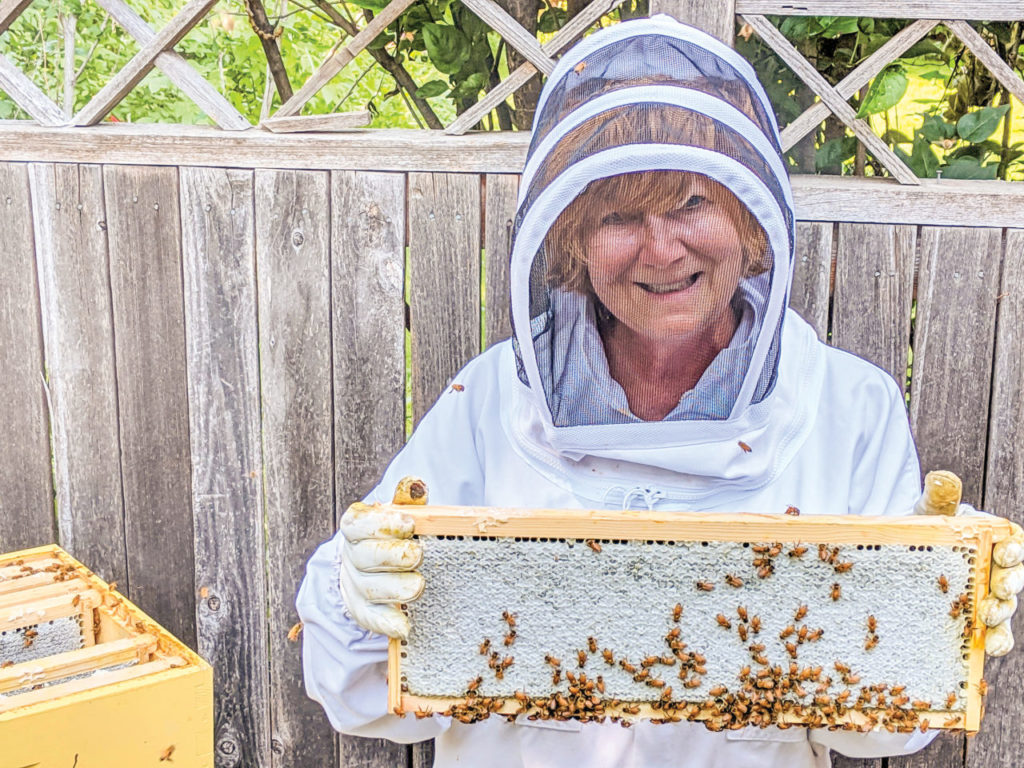
Lisa Boesen
Lisa Boesen remembers the day she bought a house in midtown Fort Collins and saw weird-looking critters hovering over the grass.
“We were like, ‘What are those things?’” Boesen says.
It turns out they were native bees. There are nearly 1,000 species in Colorado, and many don’t look like honeybees, which are non-native and intentionally introduced here. They are red, orange, green and blue, among many looks, and don’t always live in a hive. Many, in fact, are solitary.
Honeybees tend to have an overstated role in pollination here, Boesen says, as native bees do most of the work.
“I love my bees,” says Boesen, the president of the Northern Colorado Beekeeping Association who has kept bees for five years, “but I don’t think any of us feel that we are a substitute for nature. Nearly all our food is not pollinated by honeybees.”
In fact, too many honeybee hives in an area can crowd out native bees, says Steve Andrijiw, a professional beekeeping consultant with Front Range Sustainable Apiaries, who serves all major cities in Northern Colorado.
“If they are brought into an area that has insufficient natural forage for bees,” he says, “the honeybees can put native pollinators out of a job. Keeping bees is a good thing, but if there’s too many in one area, it can be a real problem.”
Native bees are wild and therefore more independent than the honeybees kept in hives, but they still need to be nurtured, Boesen says. The best way to help is to devote at least a portion of your yard to the wild.
“You should have as little grass as possible,” she says. “Use it as a pop of color and not a blanket.”
Growing a garden is sometimes enough, but if your objective is to help critters such as native bees, you can try native plants and flowers to help feed them. Boesen calls these “pollinator beds.” Spring is the perfect time to tear out grass and start establishing the native plants that feed the bees, along with many other critters. Ask for help from a nursery, or you can get books on pollinator beds or Audubon gardens. There’s always the internet as well.
“You [will] find butterflies and worms and birds and all shapes and sizes of bees,” Boesen says. “There’s just so much life in that small piece of yard.”
HOAs can no longer forbid you from taking out your lawn, according to state law, and cities may even offer grants to homeowners for moving to xeriscaping.
___________________________________________
Dan England is a mountain climber, ultrarunner, freelance writer and coach who lives in Greeley with his three kids, a son and twin girls, his singing wife Valerie, and his herding dog Pepper.


